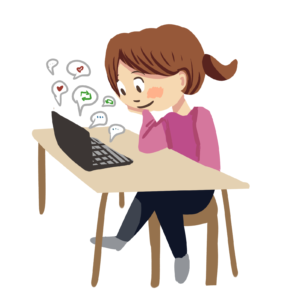by Masha Zhdanova
Networking online becomes a lot easier to understand if you just think of it as “making friends” in your field. Because that’s really what networking is: making friends that can help you get noticed by a company you like, or get a table at a convention you want to go to, or get more followers on social media. Networking is simply making useful friends.
So how do you do that?

Step one is to get a Twitter. Facebook and Instagram are great and all, but Twitter is where the online art community is concentrated. Everyone follows the same group of artists, and when something happens in comics or in animation, everyone suddenly starts tweeting about it at the same time. Additionally, editors, recruiters and employers scour Twitter for new hires.
If you already have a Twitter, make sure you’re using it. Post your art or post funny tweets about your life. What helped me get comfortable using Twitter is having a best friend that’s very active on Twitter. This friend liked, replied to and retweeted almost all my tweets, and made me feel like I was doing Twitter right. I made more friends at SCAD who tweet a lot, and that helped too. Social media is always more fun with friends.
Once you’re on Twitter, follow artists you like. If you’re hoping to work in animation or comics, follow people who are currently working your dream job. Follow studios and publishers whose work you like. Follow other art students, too, your classmates and people in other schools who have things in common with you.
I’m a sequential art student, so here are some Twitter accounts that are useful for people who make comics:
@spacetwinks: Sometimes he writes very long and informative essays about comics, and they’re very interesting.
@AnthologyComics: Often retweets comic anthologies when they put out calls for submissions.
@webcomicchat: Weekly conversation prompts about webcomics, for fans and creators. A great way to join a conversation. @comicbookhour is a similar account.
@AtlaTheWriter: Comic book writer from Finland. Really, really friendly and nice. Be her friend.
@InkDropCafe: Comics collective that specializes in sharing resources. I’ll come back to this one later.
OK, so let’s assume you’re following, like, 500 people now, and some of them followed you back. Now what?
Start a conversation!
Like I said earlier, networking is just making online friends that are useful to you. I scroll through my feed and when I see a work of art I like, I hit “retweet” and reply to the post saying I like it. If someone who’s following me tweets something I can respond to, I respond to it. My first conversation with @AtlaTheWriter happened because I tweeted about Soviet animation and she had seen the cartoon I mentioned, so we talked about it. The other day another one of my friends, a webcomic artist, asked about Inktober prompts, so I linked her to a list I saw on Tumblr. Friendship.
Twitter stands out because, unlike Instagram, it is easy to share something you like while retaining credit to the original source. It’s also easy to have a conversation with someone and to generate a lot of posts very quickly. Most artists with lots of Twitter followers, such as Anoosha Syed and Trung-le Nguyen, post selfies, pictures of their pets and reactions to the TV shows they’re watching, in addition to lots of lovely art.
Be sure to watch for hashtags for art promotion. #drawingwhileblack happened a few weeks ago and went viral, and #visiblewomen is an annual hashtag for women artists. If you draw fanart, tagging the thing that inspired the fanart is always a good move.
If Twitter’s not really your thing, consider checking out Discord servers. Discord was originally created to be a voice chat program for gamers, and evolved into Skype’s biggest competitor without video capabalities. I said we’d get back to Ink Drop Cafe later. Ink Drop Cafe has a Discord server for webcomic artists and people interested in comics, with sub-topics for sharing art, self-promotion, critique, resources and social chatting about pets, fandoms and general life and things.
There’s also the Artist Garden Discord, which is geared more towards hobbyists but is still useful for making friends, sharing your art and promoting yourself.
A Discord server is a big organized group chat, and for someone who’s more comfortable in group conversations than one-on-one message exchanges, it’s really handy. I’m in a few other servers based on shared interests and mutual friends.
Facebook is also a good way to make new friends, in addition to interacting with existing friends. The Artists Alley Network International Facebook group is a huge group for sharing tips, resources and self-promotion for artists who table at conventions and otherwise make money off their work. Every Wednesday is WIP Wednesday, when people post works in progress for feedback. Every Sunday is Self-Promo Sunday and people post links to their shops, commissions information, or social media accounts. It’s a great way to learn things about being a working artist, as well as get a few more eyes on your work.
Making friends on the internet makes the internet more fun, and being good at using the internet can make it easier for editors, art directors and recruiters to notice you and your work. Hopefully, these links and tips can help you make the internet friends you need.




















